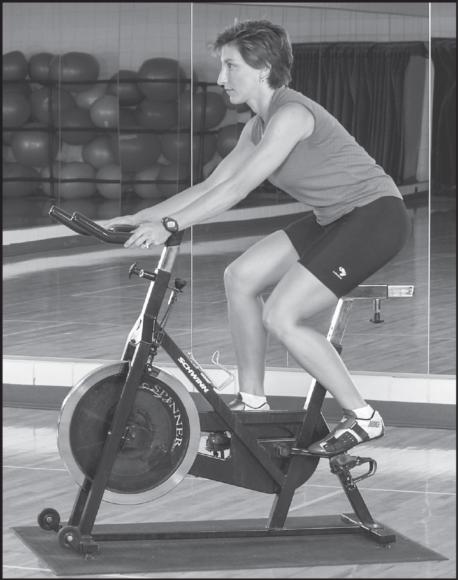Positioning, alignment,and safety in group cycling classes
This is an excerpt from Methods of Group Exercise Instruction 4th Edition With Online Video by Mary M Yoke,Carol Armbruster.
Before beginning an indoor cycling class, make certain that each participant is properly aligned and adjusted on the bike. Show up 15 minutes before class to assist participants with bike setup, answer any questions, get to know new participants, and set up your own equipment (including the music and microphone). The three main bike adjustments are the seat height, the fore and aft seat position, and the handlebar height.
Seat Height
The correct seat heightdepends on the cyclist's leg length: the longer the leg, the higher the seat. In general, when the rider is seated on the bike with the balls of the feet on the center of the pedals, there should be a slight bend in the knee of the extended leg when pedaling. Experts suggest this knee flexion should be anywhere from 5° to 30°. If the seat height is too low, inadequate leg extension may cause knee problems, especially in the front of the knee. If the seat is too high, the rider's hips will rock back and forth; in addition, the risk of knee hyperextension is increased, which may cause pain at the back of the knee. Most beginning participants err on the side of setting the seat too low in an effort to minimize saddle soreness. Proper seat height is the key to healthy knees.
Fore and Aft Positioning
For proper fore and aftpositioning, adjust the saddle so that the cyclist's front kneecap is aligned directly above the center of the pedal when the pedal is forward and the crank is horizontal (the nine o'clock position). Cycling with the saddle too far forward can cause anterior knee problems. The correct fore and aft positioning also should allow the arms to comfortably reach the handlebars with the elbows slightly flexed. In addition, a proper position of the fore and aft seat setting will reduce the sitting-bone pain beginners often feel when first starting an indoor cycling class, particularly if they do not have cycling shorts.
Handlebar Height
Handlebarheight is mostly a matter of personal preference. Some experts have shown that a higher handlebar height puts riders in a better posture position to help minimize lower-back pain while riding. Beginners are encouraged to put the handlebars higher so the torso is more upright. The upright, neutral spine position is recommended for participants with back or neck problems. The lower the handlebars, the more the cyclist simulates a racing position, which creates favorable aerodynamics when cycling outdoors but is unnecessary when riding indoors. Teach participants to ride with a relaxed grip and neutral wrists and to vary their hand positions.
Shoes and the Emergency Brake
Encourage participants to wear stiff-soled shoes that remain rigid over the pedals; students should position the feet so that the balls of the feet, not the arches, contact the pedals. Clipping the shoes onto the pedals or securely strapping the shoes into the foot cages can enhance pedaling efficiency. Because most bikes are fixed gear and have pedals that continue to rotate after the feet are taken off, remind your class members to keep their feet on the pedals until the pedals stop moving. Most indoor cycling bikes have an emergency brake that can be pressed to instantly stop the flywheel and pedal rotation should your feet become detached.
Body Alignment
Remind participants to maintain neutral spinal alignment on the bike. The rider is in a neutral spine position when the four curves of the back are in their proper relationship to each other. Maintaining this position is easiest when the rider is sitting upright with the torso perpendicular to the floor. When the rider is seated and riding with a correct forward lean, the spine is in a neutral position, albeit inclined at a 45° angle, depending on the activity (see figure 12.1). Tucking the hips under (creating a posterior pelvic tilt) causes the back to round (or flex) and places much more strain on the structures of the back and should be avoided. When using proper form, the shoulder blades are kept down and slightly retracted in a position known as neutral scapular alignment. Rounding or hunching the shoulders or allowing the shoulder blades to come up by the ears should be avoided.

Figure 12.1 Proper seated bike alignment in the inclined position.
![]() See online video 12.1 for a cycle setup demonstration.
See online video 12.1 for a cycle setup demonstration.
SHOP

Get the latest insights with regular newsletters, plus periodic product information and special insider offers.
JOIN NOW


